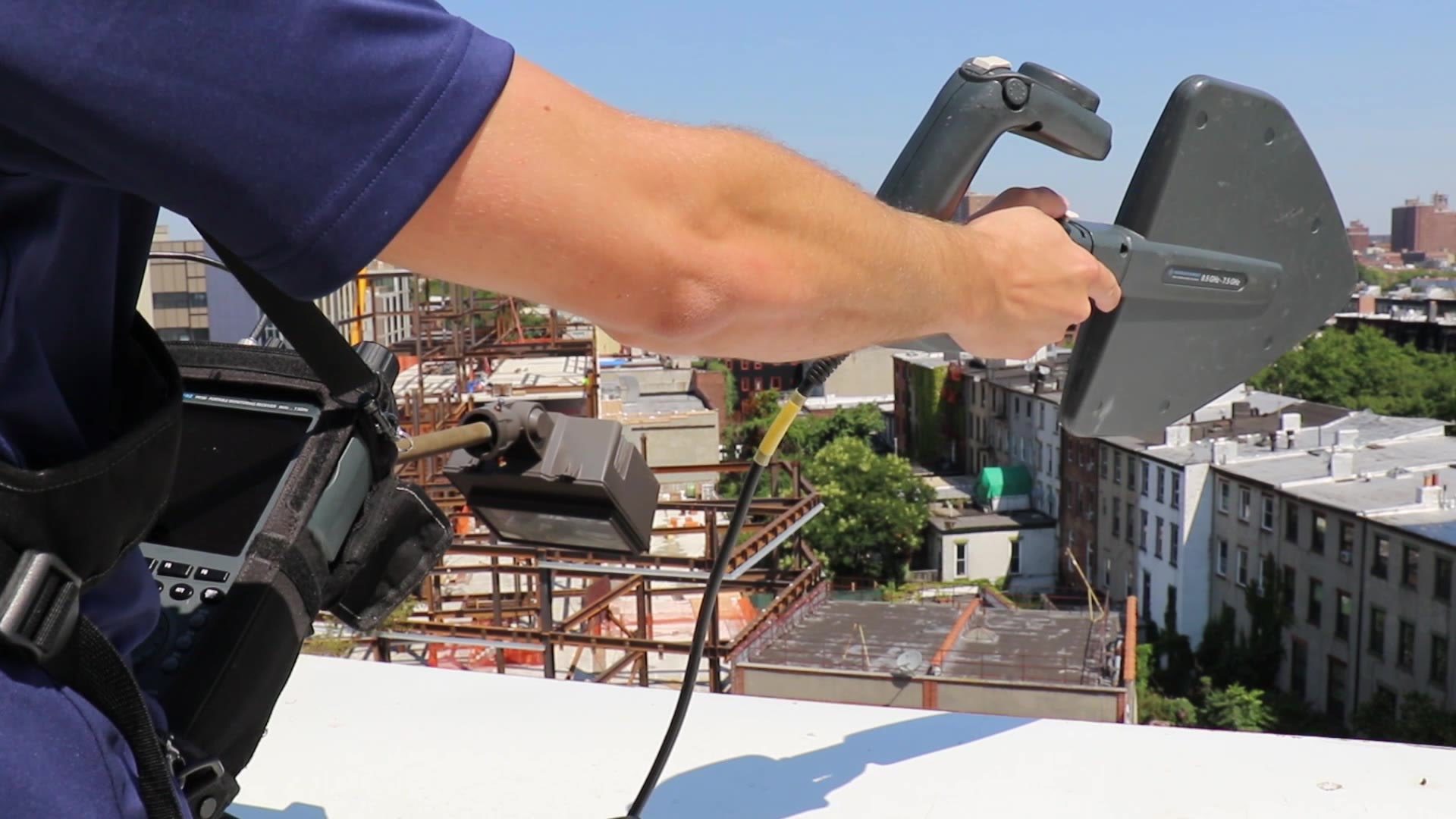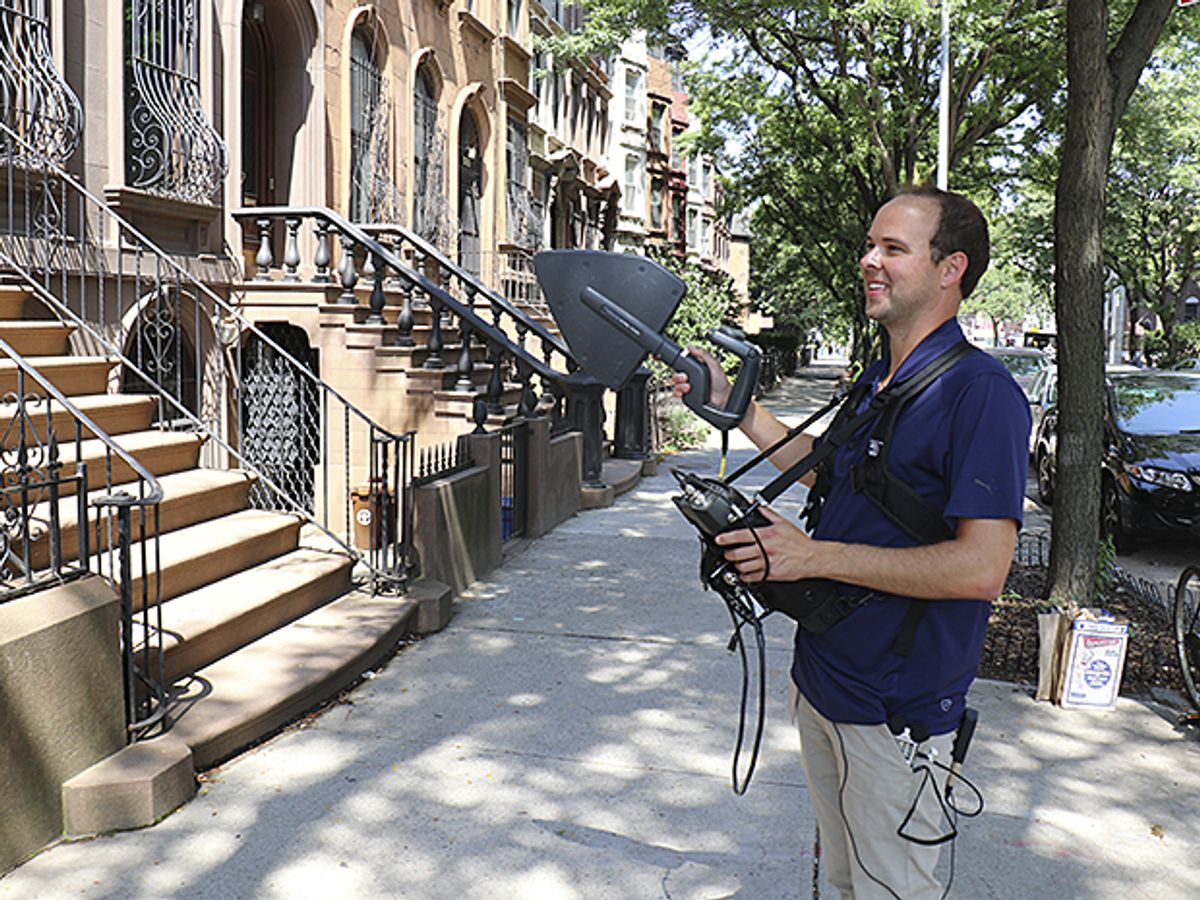It’s midday in Crown Heights, Brooklyn, and Kevin Argentieri is walking around a residential neighborhood brandishing a large gray arrow, like a medieval knight would wield a sword.
First, Argentieri stands in the middle of a sidewalk and holds the arrow out in front of him. Then, he rotates it and waves it down a street. Next, he points it directly at a house. All the while, he glances down to monitor live readings from a boxy console strapped to his chest.
The whole set-up looks rather bizarre, and somewhat suspicious in a city that constantly reminds its residents: “See something? Say something.” Curious passersby frequently ask if he’s searching for gold or looking for ghosts.
What he’s actually doing, he tells them, is trying to improve their cell phone reception. Argentieri works for P3, a company that performs radio-frequency interference hunting for nationwide carriers including Verizon, AT&T, T-Mobile, and Sprint. The device he’s waving around is a portable spectrum analyzer, a machine that helps him home in on sources of interference.
Each morning, Argentieri sets out to track down devices that are causing interference, and then tries to persuade their owners to shut them off. This is a delicate process that involves knocking on strangers’ doors, searching their homes for the offending device, and politely reminding the owner that they could be fined up to US $16,000 a day for keeping the gadget switched on.
American carriers pay big bucks to the U.S. Federal Communications Commission for exclusive licenses to swaths of the radio-frequency spectrum. In the United States, popular LTE bands include 700 megahertz, 1900 MHz, and 2.5 GHz. Once a license is sold, the FCC prohibits anyone else from transmitting in these bands.
Both carriers and regulators take this restriction seriously—electronics manufacturers must have their gadgets certified by the FCC before selling them in the United States. But some rogue devices inevitably slip through. Argentieri says baby monitors, cordless phones, and cell phone repeaters are three of the most common violators.
In some cases, these devices may have been improperly configured, causing them to transmit on the wrong band. Or, their owners may have imported them without checking whether they are licensed to operate in the United States. One of Argentieri’s hunts led him to an international cruise ship docked in New York City, which was chock-full of devices emitting signals on frequencies licensed to U.S. carriers.
Interference from any of these sources causes dropped calls for wireless customers in the area and worsens the overall performance of the network. That’s where Argentieri comes in. Most of the time, it takes him less than a day to track down a source of interference.

Network carriers constantly monitor the “noise floor,” or level of interference, at each base station. The carriers flag any increases in noise, and dispatch P3 engineers to investigate. Generally, Argentieri searches the area served by that base station. In NYC, that might consist of only a dozen blocks. But in rural areas, a search can extend much further. One of Argentieri’s most difficult hunts was in rural Texas. The source—a cell phone booster—was nearly 10 kilometers away from the base station and across a river.
When Argentieri arrives on scene, he begins by plugging his spectrum analyzer into the radio-frequency monitoring ports of the base station to reveal all the signals being transmitted to it in real time. Base station manufacturers include Ericsson, Nokia, and Alcatel-Lucent.
Once he finds the interference on his screen, Argentieri uses several key performance indicators, including received signal strength indication (RSSI) and received total wideband power (RTWP), to evaluate its severity and formulate a theory about what might be causing it. For example, an RTWP of -116 decibel-milliwatts might represent a typical amount of interference. If the actual RTWP on the analyzer was higher, say -106 dBm, Argentieri could surmise that something out there was causing extra interference.
On a recent hunt in Brooklyn, Argentieri traced interference from a client’s rooftop base station to a construction site across the street, where he believes the crew nicked a cable TV antenna. On the rooftop, the pattern on his analyzer provided his first clue—every 6 MHz, the level of interference dipped. This pattern is consistent with the shape of a cable TV signal—TV channels are 6 MHz wide, and each channel is followed by a gap to reduce interference between channels.
The interference also popped up in the 700 MHz band, which is popular with both cable TV companies and wireless carriers. Cable TV companies are permitted to use 700 MHz so long as their TV signals remain contained within the cables running to customers’ televisions.
But if one of those cables is sliced in two by construction, or chewed up by squirrels (it happens, says Argentieri), the cable starts spewing TV signals into the air. These “leaked” TV signals interfere with the cellular signals of other customers in the area who also rely on 700 MHz. Cellular signals can even bounce right back into the severed cable, distorting TV programs.
Back on the rooftop, Argentieri used his analyzer to discern the general direction of the source, which basically means he waved it around to see where the interference was strongest. Descending to the sidewalk, Argentieri walked toward that spot, holding the analyzer in front of him to monitor changes in interference with each step.
As he maneuvered around a nearby construction site, Argentieri glimpsed a thicket of black TV cables that ran from the backyards of several houses, up over a fence, and down into the site itself. But before Argentieri could spot any damaged cables that could be the source, a nervous construction manager shut a door in the perimeter fence to prevent him from peering in.
Still, the level of interference on his screen ticked up around the site, persuading Argentieri that a sliced TV cable was most likely the culprit in this case. His next step will be to inform the cable TV provider in the area of the suspected leak, and ask them to repair it.
Leaky TV cables are one of the easiest problems that Argentieri encounters. If he had traced the interference back to someone’s home, he would have knocked on the door and tried to speak to them about the problem.
Sometimes, he can help owners reprogram devices to operate at the correct frequency. Or, in the case of a cell phone repeater, reposition it to reduce interference to a particular base station. Other times, he has to inform the owner that they must throw their electronics out.
That can be awkward, but Argentieri likes spending his days outside, and the job security is good. P3 is hiring more interference hunters, and the company recently began to test drones to help out on interference hunts.
The proliferation of personal electronics means the potential for radio-frequency interference is greater than ever before. And it’s difficult and expensive for carriers to buy new spectrum. Those trends mean carriers will continue to vigorously defend the licenses they do hold—and keep Argentieri busy out on the streets.



